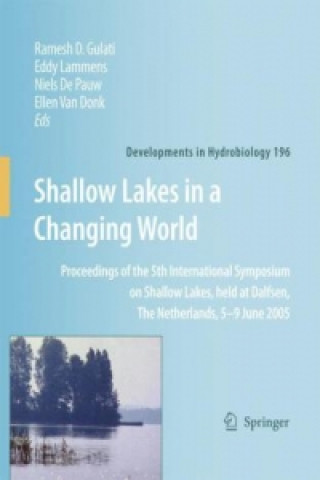
Code: 01975768
Shallow Lakes in a Changing World
by Ramesh D. Gulati, Eddy Lammens, Niels DePauw, Ellen Van Donk
Since the late 1980s, shallow lakes in Europe and North America have been receiving concerted attention from limnologists, fishery biologists and lake managers. These developments relate to deterioration of water quality in the la ... more
- Language:
 English
English - Binding: Paperback
- Number of pages: 466
Publisher: Springer, 2010
- More about this

216.16 €
RRP: 222.15 €
You save 5.99 €

In stock at our supplier
Shipping in 6 - 8 days
You might also like
-

Advanced Shotokan Karate Handbook
15.29 € -27 % -

Wasser, ein faszinierendes Element
28.67 € -9 % -

Management of Mutual Funds
120.75 € -

Does research pay?
62.08 € -2 % -

Cultures of Transnational Adoption
127.80 € -

Road to Science Fiction
33 € -

Rossiiskaia vlast' v biografiiakh III. Rukovoditeli federal'nykh sluzhb i agentstv RF v 2004 g.
38.53 €
Give this book as a present today
- Order book and choose Gift Order.
- We will send you book gift voucher at once. You can give it out to anyone.
- Book will be send to donee, nothing more to care about.
More about Shallow Lakes in a Changing World
You get 544 loyalty points
 Book synopsis
Book synopsis
Since the late 1980s, shallow lakes in Europe and North America have been receiving concerted attention from limnologists, fishery biologists and lake managers. These developments relate to deterioration of water quality in the lakes due to pollution and accelerated eutrophication, caused by increased urbanization and agriculture in the lake catchments, overexploitation of fish and higher water level fluctuations. The water-quality and management problems of lakes have led to a greater need for fundamental research on shallow lakes in order to gain a deeper insight into the structure and functioning of the food web in these waters. New knowledge relating to littoral pelagial interactions and the sediment water interface has facilitated the development of new lake restoration techniques.§This volume, with 41 peer-reviewed papers, comprises the proceedings of the 5th International Symposium on Shallow Lakes, which was held at Dalfsen, The Netherlands, on 5 9 June 2005. It has the theme Shallow Lakes in a Changing World and deals with water-quality issues, such as changes in lake limnology, especially those driven by eutrophication and pollution, increased nutrient loading and productivity, perennial blooms of cyanobacteria and loss of biodiversity. The general consensus is that the lakes under restoration respond by showing an increase in water clarity followed by an increase in macrophyte coverage and biomass. Consequently, there is now ground for theoretical speculations on the so-called alternate stable states observed in many such lakes under restoration.This volume comprises the proceedings of the 5th International Symposium on Shallow Lakes, held at Dalfsen, The Netherlands, in June 2005. The theme of the symposium was Shallow Lakes in a Changing World, and it dealt with water-quality issues, such as changes in lake limnology, especially those driven by eutrophication and pollution, increased nutrient loading and productivity, perennial blooms of cyanobacteria and loss of biodiversity.Since the late 1980s, shallow lakes in Europe and North America have been receiving concerted attention from limnologists, fishery biologists and lake managers. These developments relate to deterioration of water quality in the lakes due to pollution and accelerated eutrophication, caused by increased urbanization and agriculture in the lake catchments, overexploitation of fish and higher water level fluctuations. The water-quality and management problems of lakes have led to a greater need for fundamental researches on shallow lakes in order to gain a deeper insight into the structure and functioning of the food web in these waters. New knowledge relating to littoral pelagial interactions and the sediment water interface has facilitated the development of new lake restoration techniques. §This volume, with 41 peer-reviewed papers, comprises the proceedings of the 5th International Symposium on Shallow Lakes, which was held at Dalfsen, The Netherlands, on 5 9 June 2005. It has the theme Shallow Lakes in a Changing World and deals with water-quality issues, such as changes in lake limnology, especially those driven by eutrophication and pollution, increased nutrient loading and productivity, perennial blooms of cyanobacteria and loss of biodiversity. The general consensus is that the lakes under restoration respond by showing an increase in water clarity followed by an increase in macrophyte coverage and biomass. Consequently, there is now ground for theoretical speculations on the so-called alternate stable states observed in many such lakes under restoration.
 Book details
Book details
Book category Books in English Mathematics & science Biology, life sciences Life sciences: general issues
216.16 €
- Full title: Shallow Lakes in a Changing World
- Subtitle: Proceedings of the 5th International Symposium on Shallow Lakes, held at Dalfsen, The Netherlands, 5-9 June 2005
- Author: Ramesh D. Gulati, Eddy Lammens, Niels DePauw, Ellen Van Donk
- Language:
 English
English - Binding: Paperback
- Number of pages: 466
- EAN: 9789048176267
- ISBN: 9048176263
- ID: 01975768
- Publisher: Springer
- Weight: 1154 g
- Dimensions: 260 × 195 × 26 mm
- Date of publishing: 23. November 2010
Trending among others
-

The Molecule of More
15.79 € -24 % -

The Selfish Gene
11.87 € -24 % -

Stealing Fire
11.26 € -28 % -

Into the Magic Shop
14.18 € -25 % -

Undoing Project
10.86 € -14 % -

Race Differences in Intelligence
34.81 € -

Reaching Down the Rabbit Hole
10.36 € -29 % -

Manual of Percutaneous Coronary Interventions
93.08 € -4 % -

Systems Biology - A Textbook 2e
79.90 € -4 % -

Descent of Man
5.22 € -29 % -

Diversity of Life
13.27 € -28 % -

Sapiens
21.43 € -

Psychopath Inside
16.90 € -15 % -

Blind Watchmaker
12.77 € -23 % -

We Are Our Brains
11.36 € -20 % -

Homo Deus
10.96 € -20 % -

The Story of the Human Body
14.28 € -22 % -

Incognito
10.86 € -26 % -

Brain Rules (Updated and Expanded)
13.88 € -14 % -

Story of Life: Evolution (Extended Edition)
13.27 € -28 % -

Cosmic Serpent
10.36 € -27 % -

Speculations on the Evolution of Human Intelligence
7.94 € -22 % -

Oxygen
12.27 € -28 % -

Double Helix
10.25 € -28 % -

Power of Habit
11.97 € -24 % -

Brain
11.66 € -20 % -

The Extended Phenotype
12.97 € -24 % -

Neuroaffective Picture Book 2
35.51 € -

Descartes' Error
14.28 € -22 % -

Life on Earth
26.66 € -

The Storytelling Animal
16.80 € -16 % -

River Out of Eden
11.06 € -22 % -

Feeling Of What Happens
13.37 € -27 % -

Ancestor's Tale
15.09 € -23 % -

Symbiotic Planet
15.79 € -21 % -

Secrets of the Skeleton
23.54 € -

T. rex and the Crater of Doom
17 € -18 % -

Epigenetics Revolution
13.17 € -5 % -

Human Brain Coloring Book
17.30 € -27 % -

Affective Neuroscience
79.09 € -

Seven Daughters Of Eve
12.17 € -22 % -

Darwin's Dangerous Idea
15.19 € -28 % -

Feeling and Knowing
22.33 € -4 % -

Evolution: The Whole Story
21.22 € -24 % -

Social
15.29 € -27 % -

Systems View of Life
28.77 € -14 % -

Ecological Thought
28.37 € -7 % -

Human Advantage
14.98 € -21 % -

Updating Neanderthals
135.65 € -15 %
Collection points Bratislava a 2642 dalších
Copyright ©2008-24 najlacnejsie-knihy.sk All rights reservedPrivacyCookies


 15549 collection points
15549 collection points Delivery 2.99 €
Delivery 2.99 € 02/210 210 99 (8-15.30h)
02/210 210 99 (8-15.30h)